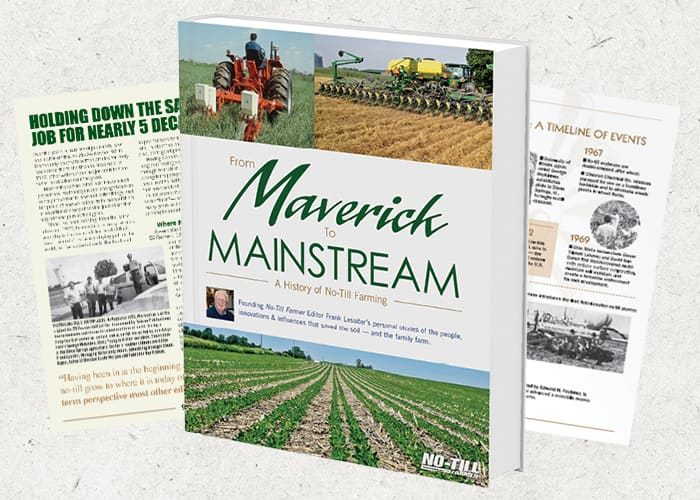One fall morning, I was scooped up and walked to my mom’s Red Cutlass and put in the backseat alongside my dog. A few hours later, Mom hurried me upstairs and dropped me in a barren bedroom. “Sit here quietly until your sisters come get you,” I recall, about 15 minutes before I got into trouble for the first time in my new home.
The year was 1972. I was 3 years old. I learned years later that the move to this place called Wisconsin was so Dad could run something called No-Till Farmer (NTF).
I’m personally proud today to tell you that Frank Lessiter’s new book, From Maverick to Mainstream: A History of No-Till Farming, has arrived. It’s Dad’s 4th book in a long and influential career as an ag journalist.
It’s a story that needed to be shared, and it’s worth celebrating. In the days of “big iron,” no-till started out as a scoffed-at practice — when many farmers joked that it was “ugly,” or even “lazy,” farming.
From Maverick to Mainstream is a chronicling of Dad’s personal history from the near-beginnings of no-till, as the only editor-in-chief of NTF since its founding in 1972. The concept was still in its infancy at that time, just 10 years after one “crazy” farmer in Kentucky tried it out on less than 1 acre.
- 416 pages, 650 photos and another 125 visuals ... with 56 entries on the Table of Contents
- Foreword by John Young, son of the late Harry M. Young, who farmed no-till’s first commercial acres
- To order a signed copy of the book (sold at $47.95), visit www.No-TillFarmer.com/historybook
Grandpa thought Dad was nuts for uprooting his family and leaving a stable job at age 33 to cover a totally foreign farming practice. Others of you told me you were worried for Dad’s reputation by attaching himself to this crazy method. He didn’t realize it at the time, but that move to Wisconsin would lead to a ringside seat for 46 years of intimately covering a single subject, and later to a company he and Mom started in 1981.
For better or for worse, Dad and NTF were in it together. When the ag recession of the 1980s nearly killed his new company, Dad double-downed on NTF. His diligence was rewarded by you and your families, who mailed the subscription checks that provided just enough cash flow to continue the newsletter and rebuild as a 3-person company in the early 1990s. Today, we employ nearly 40 across several ag publications, digital properties and conferences.
During Dad’s time covering no-tillage, the U.S. no-till acreage increased 29 times to more than 100 million acres today. Attendees at the annual National No-Tillage Conference have told us how no-till changed their lives and even saved their farms during the 1980s — by taking on more land with less equipment and labor, and learning how to modify planters and drills before they were commercially available by manufacturers. I’ve even heard Dad called the “Johnny Appleseed of No-Till” for providing a forum in the pages of NTF (and later the National No-Tillage Conference) where farmers could learn about and exchange knowledge on a promising but difficult way to farm.
This 416-page volume is much more than just a history book. It covers the people and their trials and successes. Anyone interested in stories of early adopters and underdogs who changed the world will enjoy it. It serves as a lasting reminder of how innovations, and their determined personal champions like those profiled in the book, can make a difference — through grit, learning and sharing, and the encouragement and support of others.
We’ve given Dad a hard time about this project’s deadline almost since he officially started digging into 40-plus years of archives of articles, photos, comic strips, ads and infographics. But I will tell you it’s been worth the wait. I’m proud of the contributions of Dad, and what he — and you in the no-till community — accomplished together since 1972. Take a bow.







